|
|
Ini ada hal aku nak tanya Muslims :
Source : https://my.entertainment.yahoo.c ... -nuh-092100470.html
"Segala perbuatan yang menggambarkan rasul dan nabi serta pada sahabat boleh memprovokasi emosi umat Islam serta memberi kesan pada undang-undang Islam dan hal sedemikian adalah sangat bertentangan dengan darjat seorang nabi dan utusan Allah," jelas Al-Azhar dalam satu kenyataan.
Ini soalannya :- Macam mana aksi seorang pelakon boleh menjejaskan "darjat" seorang Nabi dan Rasul? Aku tak faham. Bodoh sangat kah orang Islam sampai tak boleh menbezakan fakta agama dgn lakunan semata2? |
|
|
|
|
|
|
|
|
|
|
|
By Sephiroth
Ini soalannya :- Macam mana aksi seorang pelakon boleh menjejaskan "darjat" seorang Nabi dan Rasul? Aku tak faham. Bodoh sangat kah orang Islam sampai tak boleh menbezakan fakta agama dgn lakunan semata2?
Lakonan takkan menjejaskan pulak darjat Nabi.
Dia cakap ikut suka hati je, tak guna logik.
|
|
|
|
|
|
|
|
|
|
|
|
kid posted on 10-4-2014 01:00 AM 
Banyak pandangan berbeza pasal tudung ini. Tapi sebenarnya tudung ini menjadi popular mulai tahun 80 ... Banyak pandangan berbeza pasal tudung ini. Tapi sebenarnya tudung ini menjadi popular mulai tahun 80an.
Saya masih ingat dulu nenek dan Ibu saya tak pakai tudung, tapi pakai kain selendang yg tutup rambut atas sahaja. Istri ulama terkenal macam Hamka pun tak pakai tudung jugak.
Pendapat saya tudung taklah wajib, kerana dalam surah An Nisa yg dipentingkan adalah menutup dada.
Saya tak kata pendapat yg mengutamakan tudung itu salah. Terpulang saja pendapat masing masing.
Sebab itulah melayu muslims dulu rambut lebat berbanding skg....
menutup dada itu lah yg penting....kalau wanita sangat cantik sehingga ada lelaki usik atau menganggu , maka dia boleh tutup seluruh badan...perkara2 ini tidak berlaku di malaysia..cuma di india dan arab mungkin...
|
|
|
|
|
|
|
|
|
|
|
|
eniliana posted on 10-4-2014 08:00 AM 
kalau tak gugur langsung itu menipu namanya...gugur mcm manusia biasa punya rambut.
mungkin anuge ...
ok, thanks for info
|
|
|
|
|
|
|
|
|
|
|
|
sam1528 posted on 10-4-2014 10:17 AM 
Ooh , ikut Padri Truth.8 dlm bible tak payah pakai tudung walaupun 1cor11:6 adalah sebaliknya.
...
kita pun tak tahu macam mana rupa dan pakaian Mary...kalau nun itu lain lah sebab merek fully devoted to GOD and being single for their life for the purpose of spirituality ...
like I said, not necessary to cover the head with scraft or tudung....if in place of worshipped is ok
Last edited by Truth.8 on 10-4-2014 03:09 PM
|
|
|
|
|
|
|
|
|
|
|
|
Truth.8 posted on 10-4-2014 02:01 PM 
kita pun tak tahu macam mana rupa dan pakaian Mary...kalau nun itu lain lah sebab merek fully dev ...
Mary was a levite belonging to the priestly class. Therefore she veiled herself according to the Torah.
You mean nuns cover themselves as they devoted themselves to God? Meaning other christians like you do not devote yourself to God?
|
|
|
|
|
|
|
|
|
|
|
|
kid posted on 10-4-2014 12:54 PM 
Lakonan takkan menjejaskan pulak darjat Nabi.
Dia cakap ikut suka hati je, tak guna logik.
Dia (pelakon) tak cakap sesuka hati dia. Dia ikut script yg diberikan oleh pengarah. SEBAB ITULAH DIA DIGELAR PELAKON. Faham?
Film Hollywood, Bollywood etc BUKAN DOCUMENTARY SEJARAH.
Oleh itu, macam mana orang Islam boleh kata film lakunan semata2 ini boleh menjejaskan darjat Nabi kamu? Tak ada logik langsung.
Tetapi buat juga fatwa bodoh. 
Setakat ini tak ada pula fatwa melarang akitiviti menculik orang bukan Islam utk duit (spt yg dilakukan oleh Abu Sayyaf di Philiphines) - tak haram kah duit itu?
Setakat ini tak ada pula fatwa mengatakan bahawa kegiatan keganasan itu dilarang dlm Islam secara rasminya - satu bukti bahawa Islam memang menyokong kegiatan keganasan.
|
|
|
|
|
|
|
|
|
|
|
|
sam1528 posted on 11-4-2014 12:18 AM 
Mary was a levite belonging to the priestly class. Therefore she veiled herself according to the T ... Mary was a levite belonging to the priestly class. Therefore she veiled herself according to the Torah.
You mean nuns cover themselves as they devoted themselves to God? Meaning other christians like you do not devote yourself to God?
Jeus never spoke about covering the head....so does the Bible spoek anything about covering the head....as for mary, it was during that time. for nun they choose that way..it their choice....the fact , having cover hair is not a must but one must groom it nice and neat
|
|
|
|
|
|
|
|
|
|
|
|
Sephiroth posted on 11-4-2014 08:47 AM 
Dia (pelakon) tak cakap sesuka hati dia. Dia ikut script yg diberikan oleh pengarah. SEBAB ITULAH ...
Sephiroth posted on 11-4-2014 08:47 AM 
Dia (pelakon) tak cakap sesuka hati dia. Dia ikut script yg diberikan oleh pengarah. SEBAB ITULAH ...
Ya lah, semua orang ikut-ikut saja, dia ikut Pengarah dia. Pengarah dia ikut siapa-siapa ntah.
Tapi sangat jarang yang ikut kata Tuhan.
Kalau ikut kata Tuhan semua perkara pelik ni takkan ada. Semua perkara pelik ni kerana perbuatan manusia sendiri.
|
|
|
|
|
|
|
|
|
|
|
|
Truth.8 posted on 11-4-2014 10:55 AM 
Jeus never spoke about covering the head....so does the Bible spoek anything about covering the ...
This is where I say that you have been inconsistent. Now you bring up the point that Jesus never state to cover up or adorn the veil. You must remember , biblical Jesus was a Torah ovservant Israelite. He did not know anything of the New Testament.
If you have such mentality , 90% of the New Testament is by someone else. What biblical Jesus stated in the NT is about 10% only.
You have a problem here
|
|
|
|
|
|
|
|
|
|
|
|
kid posted on 11-4-2014 12:01 PM 
Sephiroth posted on 11-4-2014 08:47 AM
Dia (pelakon) tak cakap sesuka hati dia. Dia ikut script ...
Apa benda yg kamu mengarut ini? Kan dah kata ianya hanya lakunan semata2? Apa gunanya taruk "kata2 tuhan" dalam itu? Dari mana datangnya kata2 tuhan itu? Kamu faham ke perkataan "lakunan" dan "hiburan"?
Ini BUKAN Documentary Sejarah lah. Kalau documentary sejarah pun, mesti ada fakta agama DAN fakta sejarah yg selaris dgn satu sama lain. Tak boleh main tembak je. Dan kamu masih belum menjawab lagi persoalan aku - macam mana lakunan pelakon kini boleh menjejaskan darjat seorang Nabi atau Rasul yg hidup lebih seribu tahun yg lalu - ITU PUN KALAU betul lah perkara sedemikian berlaku dan adanya seseorang yg bernama Noh itu.
|
|
|
|
|
|
|
|
|
|
|
|
By Sephiroth
macam mana lakunan pelakon kini boleh menjejaskan darjat seorang Nabi atau Rasul yg hidup lebih seribu tahun yg lalu
Aku dah jawab, kau kena tengok balik jawaban aku.
TAK TERJEJAS LANGSUNG... takde kaitan apapun, macamana nak terjejas darjat pulak.
|
|
|
|
|
|
|
|
|
|
|
|
sam1528 posted on 11-4-2014 02:20 PM 
This is where I say that you have been inconsistent. Now you bring up the point that Jesus never s ...
I would says that during Bibical times all those covering the head is a cultural . this also trace back in India when hindu women cover their head cloth and as well shikh womens while in place of worshipped . it all cultural . not necessary to practise in present time as long moderate grooming.
Should Christian women wear head coverings?"
Answer: 1 Corinthians 11:3-16 addresses the issue of women and head coverings. The context of the entire passage of 1 Corinthians 11:3-16 is submission to the God-given order and "chain of command." A "covering" on a woman's head is used as an illustration of the order, headship, and the authority of God. The key verse of this passage is 1 Corinthians 11:3 "But I want you to know that the head of every man is Christ, the head of woman is man, and the head of Christ is God." The implications of this verse are found in the rest of the passage. The order is: God the Father, God the Son, the man or husband, and the woman or wife. The veil or covering on the head of a believing Corinthian wife showed that she was under the authority of her husband, and therefore under submission to God.
Within this passage is also verse 10: "For this reason the woman ought to have a symbol of authority on her head, because of the angels." Why is that important to angels? The relationship of God with men is something that angels watch and learn from (1 Peter 1:12). Therefore, a woman's submission to God's delegated authority over her is an example to angels. The holy angels, who are in perfect and total submission to God, expect that we, as followers of Christ, be the same.
This covering not only means a cloth but also can refer to a woman's hair length. How can we say that? We must take this verse in the context or the setting in which it is presented. "Does not even nature itself teach you that if a man has long hair, it is a dishonor to him? But if a woman has long hair, it is a glory to her; for her hair is given to her for a covering" (1 Corinthians 11:14-15). Therefore, in the context of this passage, a woman who is wearing her hair longer marks herself out distinctively as a woman and not a man. The Apostle Paul is saying here that in the Corinthian culture, when a wife's hair was longer than her husband's, it showed her submission to his headship. The roles of the male and female are designed by God to portray a profound spiritual lesson, that is of submission to the will and the order of God.
But why is hair an issue in this passage? The apostle Paul is addressing an issue related to the Corinthian culture that was being allowed to disrupt the church. For a woman to have a shaved head was a disgrace (and, in Jewish thinking, a sign of mourning, Deuteronomy 22:12). Her hair was her “glory” (1 Corinthians 11:15). In the Corinthian culture, women normally wore a head covering as a symbol of their submission to their husbands. Paul affirms the rightness of following that cultural mandate—to dispense with the head coverings on women would send the entirely wrong signal to the culture at large. In fact, Paul says that, if a Christian woman refuses her head covering, she might as well shave her hair off, too (verse 6). A woman who refused to wear a covering in that culture was basically saying, “I refuse to submit to God’s order.” Therefore, the apostle Paul is teaching the Corinthians that hair length or the wearing of a “covering” by the woman was an outward indication of a heart attitude of submission to God and to His established authority.
God's order is that the husband is the head of the wife as God is the head of Christ, but there is no inequality or inferiority implied. God and Christ are equal and united, just as the husband and the wife are one. This is not a passage that teaches the woman is inferior to man or that she should be submissive to every man. It is teaching God's order and spiritual headship in the marriage relationship. In the Corinthian culture, a woman who covered her head during worship or when she was in public displayed her submission to authority.
In today's culture, we no longer view a woman's wearing of a head covering as a sign of submission. In most modern societies, scarves and hats are fashion accessories. A woman has the choice to wear a head covering if she views it as a sign of her submission to the authority of her husband. However, it is a personal choice and not something that should be used to judge spirituality. The real issue here is the heart attitude of obedience to God's authority and submission to His established order “as to the LORD” (Ephesians 5:22). God is far more concerned with an attitude of submission than an outward display of submission via a head covering. First Timothy 2:9-10, "I also want women to dress modestly, with decency and propriety, not with braided hair or gold or pearls or expensive clothes, but with good deeds, appropriate for women who profess to worship God."
Last edited by Truth.8 on 12-4-2014 09:15 AM
|
|
|
|
|
|
|
|
|
|
|
|
Truth.8 posted on 11-4-2014 09:49 PM 
I would says that during Bibical times all those covering the head is a cultural . this also trace ...
This is where you have been very inconsistent. I reproduce your statement in post #29
Jeus never spoke about covering the head....so does the Bible spoek anything about covering the head....as for mary, it was during that time. for nun they choose that way..it their choice....the fact , having cover hair is not a must but one must groom it nice and neat
If I am to apply your logic , your argument does not stand as biblical Jesus never said such thing. Biblical Jesus was an Israelite following the Torah. I don't need to point out the number of verses in the OT that their womenfolk adorn the veil. Therefore biblical Jesus outlook should be what is in the Torah.
You need to be consistent
|
|
|
|
|
|
|
|
|
|
|
|
sam1528 posted on 12-4-2014 10:28 AM 
This is where you have been very inconsistent. I reproduce your statement in post #29 If I am to apply your logic , your argument does not stand as biblical Jesus never said such thing. Biblical Jesus was an Israelite following the Torah. I don't need to point out the number of verses in the OT that their womenfolk adorn the veil. Therefore biblical Jesus outlook should be what is in the Torah.
You need to be consistent
The whole chapther in Bible never menton that women should cover the head /or hair. Like I mentioned it is tradtional /or cultural before came Christian and Islam.
Even ancient Egypt started about 5000 years ago, when the rule of the pharaohs women and men do cover their head ...it all traditional and cultural...and the cultural extend to India ....
So, it was borrowed even Jesus time until muhammad , yet the Bible never says anything about such covering head . I hve provide fact and bible above...
Headcovering Customs of the Ancient World
An Illustrated Survey, by Michael MarloweI offer this survey of ancient headcovering practices in the hope that it will clear away some common misconceptions, and bring into sharper focus the customs which many biblical expositors have held to be so important for an understanding of the Apostle Paul's instruction to the Corinthians regarding headcoverings. Too often I find that the statements made by biblical expositors on this subject are inaccurate and simplistic. The more research I have done on the subject, the more I have come to see how problematic is the widely-accepted interpretation of 1 Corinthians 11:2-16 which asserts that Paul is merely urging the saints in Corinth to conform to local and secular customs. In my opinion this idea raises more problems than it solves. I conclude that Paul's explanations pertain to an established Christian custom, which may or may not have corresponded to any Jewish, Greek, or Roman custom of the time. Most "cultural background" treatments of this subject have failed to recognize the importance of the fact that in the first century the Church was itself a sub-culture, having its own traditions and customs. This survey was prepared as a supporting document for my exegetical commentary on 1 Corinthians 11:2-16, to which I refer the reader for more specific comments on Paul's explanation of the early Christian custom.
February 2005
Ancient Dress in General In ancient times men did not wear trousers, and women did not wear skirts. There were no shirts or blouses such as we wear today, either. Both sexes usually wore flowing garments comparable to the modern woman's dress. (1) In the Greek language the basic article of clothing was called the chiton (χιτών), and in the Latin language it was called the tunica. (2) In general, women wore a long chiton that reached all the way to the ankles. Over the chiton another garment, called the himation (ἱμάτιον), was worn (see figure 1). In the Latin language this was called the palla (for women) or the pallium (for men). The toga was a garment like the pallium, more elaborately draped, and worn only by Roman citizens. These upper garments ( himation, pallium, toga) were just large oblong pieces of cloth wrapped around the body in various ways.  Often a man would wear only the chiton. Working men would typically wear a short chiton which did not reach the knees ( figure 2). This was to give free movement to their legs while running or working. The length of the chiton was adjusted by pulling it up over a belt. Sometimes a man would wear only the himation, without the chiton, but this manner of dress was unusual — it was associated with philosophers and religious ascetics. In general, it should be noted that women were more fully covered up with clothes than men were, and women's garments were often dyed in brighter colors. There are a number of ancient texts and artifacts which clearly indicate that headcovering customs varied from time to time and from place to place. Some of these customs pertained specifically to religious cults, ceremonies, offices, and exercises. Some of them pertained to women, and others to men. I will discuss the customs of the Greeks, Romans, and Jews separately below. But it is important to recognize that in the first century there was a mixture of cultures throughout the Mediterranean lands: many Jews even in Palestine had become "Hellenized" (imitating the Greeks); several cities on Greek soil were founded or refounded as Roman colonies; in Rome there was a great influx of people from Greece and other regions, and much of the population there spoke Greek. Greek-speaking Jews had spread all over the ancient world. So it is likely that in any given city there were various customs connected with different ethnic groups, and this is especially likely to have been the case in a city like Corinth. Greek Customs of Dress
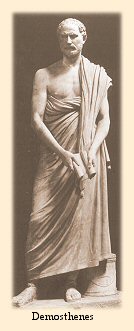
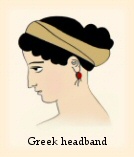
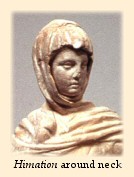
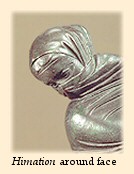
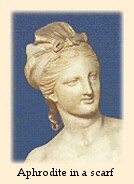
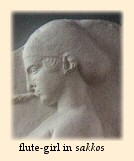
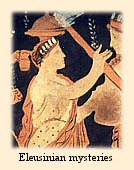

Among the Greeks it seems that men did not ordinarily wear anything on their heads for worship of their gods, or in public generally. It is well-known that Greek men tended to minimize their clothing. Even nudity was not considered shameful among them in certain contexts. Because the climate in Greece is warm, men would sometimes wear nothing more than a scanty mantle called a chlamys fastened around the right shoulder, leaving the entire right side of their bodies exposed ( figure 3). Sometimes a man would wear only the himation ( figure 4), and it was customary for philosophers and poets to dress in this manner. Greek women were expected to fully cover their bodies. For instance, a woman would not gird up her chiton like a man and display her legs in public. But the Greek headcovering customs for women during the first century are hard to determine with any degree of certainty. In the past, some biblical expositors casually asserted that all respectable Greek women wore headcoverings, and that among the Greeks (as among the Jews) only disreputable women went about with bare heads. But there does not seem to be any good evidence for this in ancient sources. (3) Many scholars now maintain that although Greek women certainly did wear headcoverings at times, and probably more often than not in public, there is no good reason to think that Greek women were under some compulsion to cover their heads in public. The idea that immoral women were recognized as such by the absence of a headcovering has no basis at all in ancient evidence. Our most important sources of information about the clothing of Greek women are the many depictions of women to be found on ancient pottery. These depictions usually show women with their hair done up in a knot and wearing a band of cloth wrapped around the head to keep the hair in place, but these bands do not cover the head on top ( figure 5 and figure 22), and sometimes there is no hair-band ( figure 27). We should beware of putting too much weight upon this evidence, however, because it may be that in these illustrations the women are depicted without headcoverings because they are at home, and perhaps it was merely a convention of Greek art to portray women in this way. It is hard to tell from the depictions alone whether or not the women are in a public setting. 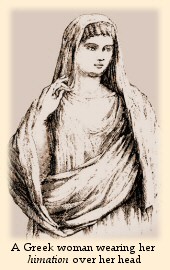 In the ancient illustrations and sculptures that do show Greek women with covered heads, the headcovering is usually just the himation pulled over the top and back of the head ( figure 6). Sometimes it is shown over the head and wrapped around the neck, without covering the face ( figure 7). One famous artifact (a bronze statuette in the Metropolitan Museum of Art) shows a woman with her himation wrapped across the lower part of her face ( figure 8), but this is unusual. The statuette portrays a dancer, and some scholars think that it was made in Alexandria (4) Many illustrations show women wearing a himation around one or both shoulders, without having it over their heads. Aside from the himation, there are other headcoverings in the ancient pictures also. A woman might wear a scarf tied closely around her hair ( figure 9), a small shawl draped over her head (called a kaluptra, resembling the modern mantilla), or a kind of snood, called a sakkos ( figure 10). Sometimes snoods and scarves are seen on women who are depicted nude, and here obviously the coverings were merely ornamental, and not worn because of any ideas about proper dress. Still less do they symbolize modesty, or marriage, or anything of the sort. None of these pictures or artifacts prove (or disprove) what Greek women were expected to wear in public. One statement commonly cited as evidence about the headcovering customs of Greek women is in Plutarch's Sayings of Spartans (written during the first century a.d.). Concerning a Spartan he writes, "When someone inquired why they took their girls into public places unveiled, but their married women veiled, he said, 'Because the girls have to find husbands, and the married women have to keep to those who have them!'" (5) This seems to indicate that in Sparta married women usually covered their heads in public and unmarried women did not. But there are a few considerations which lessen the usefulness of this statement. For one thing, Plutarch's purpose here is to record an amusing saying, not to describe a current custom. For another, it should be borne in mind that ancient Greece was not a monolithic culture: customs varied fom city to city in Greece, and the customs of Sparta are often mentioned as being peculiar, different from those of Athens and other cities. Finally, it should perhaps be noted that the Spartan to whom the saying is attributed is one Charillus, a king of Sparta in the eighth century b.c. In the same work, Plutarch also attributes to this Charillus a saying "in answer to the man who inquired why they [i.e. the men] wore their hair long." But this custom of long hair on Spartan men was from a much earlier time, according to the Greek historians, and by the time of Plutarch it was no longer customary for Spartans to have long hair. So it cannot be taken for granted that the feminine custom mentioned in this same context refers to a custom in force during the days of Plutarch. 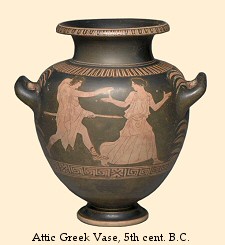 Regarding religious practices, there are clear indications that in some pagan religious observances it was the custom for women to take part with their heads uncovered. The cult of the goddess Demeter involved certain rites called the Eleusinian mysteries. A depiction of the Eleusinian mysteries on the Ninnion Tablet ( figure 11, from the fourth century b.c.) in the National Archaeological Museum of Athens shows women wearing only tiaras or leaf chaplets in their hair. In the Rule of the Andanian Mysteries it is stipulated that the initiates "are all to be wreathed with laurel" and that none of the women are to wear a "hair band, or braided hair." (See the text of the rules concerning clothing on the page, Ritual Clothing in the Andanian Mystery Cult). In the worship of Dionysus, the female celebrants known as maenads not only came with uncovered heads but also let down their hair and danced in the public processions. Many ancient paintings show women presenting offerings at altars—probably as priestesses—without headcoverings ( figure 12). The amount and the variety of this pictorial evidence makes it virtually certain that, in cultic contexts at least, Greek women did not always cover their heads in public.
Last edited by Truth.8 on 12-4-2014 02:25 PM
|
|
|
|
|
|
|
|
|
|
|
|
Truth.8 posted on 12-4-2014 01:31 PM 
The whole chapther in Bible never menton that women should cover the head /or hair. Like I menti ...
Roman Headcovering Customs








It is known that Roman priests covered their heads in religious ceremonies ( figure 13). Some ancient statues of Caesar Augustus show him with a covered head ( figure 14) because he was the Pontifex Maximus of Rome, and because he was interested in promoting the "traditional values" of the Romans, for political reasons. (6) Because Corinth was a Roman colony, some scholars have recently suggested that the Apostle Paul is referring to this Roman custom in 1 Corinthians 11:4. Presumably Roman citizens in Corinth would have observed their Roman customs when worshipping Roman gods. But it seems rather far-fetched to think that Greek Christians in Corinth would have imitated this custom of Roman priests. Even among the Romans, not all gods were worshipped with covered heads. In connection with religion, there is an interesting passage in Tertullian's On the Pallium which indicates that there were a number of different customs of dress associated with different cults. While recommending the old-fashioned pallium to Carthaginians he ridicules the novelties introduced by exotic cults, saying, "for the sake of an all-white dress, and the distinction of a fillet, and the privilege of a helmet, some are initiated into the mysteries of Ceres; while, on account of an opposite hankering after sombre raiment, and a gloomy woollen covering upon the head, others run mad in Bellona's temple; while the attraction of surrounding themselves with a tunic more broadly striped with purple, and casting over their shoulders a cloak of Galatian scarlet, commends Saturn to the affections of others." (7) The cult of Isis, which was imported from Egypt during the time of Augustus, and was especially popular among women, featured ceremonies in which priests covered their heads but priestesses did not ( figure 31). The virgin priestesses of Vesta — called Vestal virgins — wore a special headcovering called a suffibulum ( figure 15). This was a square piece of cloth that covered only the head (and perhaps the shoulders). On Roman coins of the first century the civic virtue of pietas, "piety," is personified as a woman with such a headcovering ( figure 16), and another headcovering like it may be seen on ancient representations of Christian women carved into the walls of the Roman catacombs ( figure 17). Another similar headcovering was the bridal veil ( figure 18, discussed below). The suffibulum and bridal veil are thought to be ceremonial relics of the headcovering commonly worn by Roman women in very ancient times, called the ricinium — a shawl which covered only the head and shoulders. It seems that the ricinium fell into disuse when Roman women began to wear the palla. Another personification on Roman coins was pudicitia, "modesty" or "chastity," portrayed as a goddess covering her head with a palla. (8) These coins of the Empire celebrated the old Republican virtues. However, the other side of the coins often bore portraits of honorable ladies of Caesar's house—with their heads uncovered ( figure 19). Concerning ordinary Roman women of the first century, Plutarch in one place implies that it was "more usual for women to go forth in public with their heads covered." (9) But it is unclear to what extent Plutarch's "more usual" indicates a custom strictly adhered to. We do know that in the first century Roman society was undergoing changes, in a direction which can only be called morally dissolute. Ovid (43 b.c.–a.d. 17), in the generation preceding Paul, provides an impressive testimony to the sad state of Roman morals in his book Ars Amatoria (The Art of Love), with much explicit discussion of female dress, hairstyles and cosmetics. His advice to ladies concerning hairstyles and wigs would be pointless if the ladies went out with their heads covered. If Ovid's representation of Roman society is at all accurate, (10) it is hard to believe that there was any strict observance of headcovering customs in daily life. (Likewise the Apostle Paul's remark about braided hair in 1 Timothy 2:9 implies that in his experience women prided themselves on elaborate hairstyles, which is impossible with a headcovering.) Regarding the customs observed by the middle class, we note that it is not unusual to see merchant women portrayed without headcoverings in ancient Roman art (see figures 28, 29, 30). At about a.d. 200, Tertullian in Carthage (a Roman colony, like Corinth) wrote, "some, with their turbans and woollen bands, do not veil their head, but bind it up; protected, indeed, in front, but, where the head properly lies, bare. Others are to a certain extent covered over the region of the brain with linen coifs of small dimensions ... and not reaching quite to the ears" ( On the Veiling of Virgins, chap. 17). So there are a number of independent sources which pretty clearly indicate that Roman women did not always cover their heads in public. The Romans had a special headcovering custom for brides, as we do today. The bridal veil was a piece of cloth called a flammeum (lit. "flame-colored"), because it was dyed bright orange, and it was draped over the bride's head without covering her face ( figure 20). Recently some biblical expositors have asserted that in Rome a married woman would always keep her head covered as a sign that she was married, but this assertion is not very well supported by ancient sources. The "veiling of the bride" spoken of in ancient sources pertains only to the wedding ceremony, not to a change of ordinary clothing. There was one garment, however, that did have marital significance among the Romans. It was a sleeveless robe called a stola, worn over the tunica ( figure 21). Traditionally, married women were expected to wear this extra layer of clothing in public. But in the first century this custom was apparently losing its force. Married women began to appear in public without the stola, and this gave rise to some complaints from conservative-minded Romans. There was some discussion about it in the Roman Senate, and severe legal steps were taken so as to compel married women to wear the stola, but it does not seem to have had the desired effect. At the end of the second century Tertullian makes reference to the ineffective decrees in Rome, where women had "abjured the stole," among other things, that they may go about "more openly" ( On the Pallium, chapter 4). He declares that in Rome he sees "no distinction left in dress between matrons and harlots" ( Apology for the Christians, chapter 6). So much for Rome and its customs of dress. There is plenty of evidence that it was more usual for women to cover their heads, as Plutarch implies, but the ancient sources give us little reason to think that in the first century a respectable Roman woman would never appear in public with her head uncovered. The censorious remarks of Tertullian, which are connected with his Christian critique of pagan society, would probably have been dismissed as curmudgeonly by most people in Rome. Jewish Customs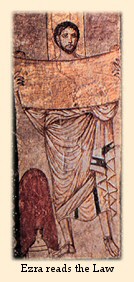 As indicated above, many of the Jews of the first century were Hellenized, having adopted many of the customs of the Greeks. But for the most part, Jews were interested in maintaining their own ethnic identity wherever they lived. They held to Jewish customs which set them apart from their Gentile neighbors. God had said: After the doings of the land of Egypt, wherein ye dwelt, shall ye not do: and after the doings of the land of Canaan, whither I bring you, shall ye not do: neither shall ye walk in their ordinances. (Leviticus 18:3. cf. also Deuteronomy 12:29-32 and 2 Kings 17:13-15.)
This principle extended even to clothing, as in the prophet Zephaniah: The LORD has prepared a sacrifice and consecrated his guests ... and on the day of the LORD's sacrifice, I will punish ... all who array themselves in foreign attire. (Zephaniah 1:8)
The Lord had given a certain commandment to Moses regarding clothing, with an explanation for its reason: Speak to the people of Israel, and tell them to make tassels on the corners of their garments throughout their generations, and to put a cord of blue on the tassel of each corner. And it shall be a tassel for you to look at and remember all the commandments of the LORD, to do them, not to follow after your own heart and your own eyes, which you are inclined to whore after. (Numbers 15:38-39. See also Deuteronomy 22:12, You shall make yourself tassels on the four corners of the garment with which you cover yourself.)
Therefore in ancient times all Jews wore such tassels on the corners of their upper garments (i.e. upon the four corners of the himation), as a reminder to themselves that they were God's people, and under His law. As Matthew Henry explains further: The Jews being a peculiar people, they were thus distinguished from their neighbours in their dress, as well as in their diet, and taught by such little instances of singularity not to be conformed to the way of the heathen in greater things. Thus likewise they proclaimed themselves Jews wherever they were, as those that were not ashamed of God and his law. Our Saviour, being made under the law, wore these fringes; hence we read of the hem or border, of his garment (Matt. ix. 20).
 Regarding headcoverings, some biblical commentators in the past maintained that the custom observed in medieval times, in which Jewish men wore prayer shawls on their heads ( figure 22), prevailed even in the first century, so that Paul's instruction regarding the men is opposed to the Jewish practice of his times. But this is not likely to be correct. Most scholars believe that the prayer shawl is a later custom which came into general use among Jews during the third century. (11) In the first century a Jewish man would often wear something on his head, for practical reasons (protection from the hot sun or from cold wind), but there was apparently no cultural expectation that he should cover or uncover his head at specific times. If Paul's rule regarding men covering their heads differs from Jewish custom, it would be in the direction of prohibiting something which was a matter of indifference among the Jews. As for Jewish women, there is clear evidence that in the first century they covered their heads not only for prayer but whenever they were outside of their own home. It is said that some Jewish women kept themselves covered at all times. In public, they not only covered their heads, but the lower part of their faces as well. For the women this was a matter of morals, and a religious duty, not merely a matter of style or convenience. Joachim Jeremias describes the Jewish custom. Eastern women take no part in public life. This was true of Judaism in the time of Jesus, in all cases where Jewish families faithfully observed the Law. When the Jewess of Jerusalem left her house, her face was hidden by an arrangement of two head veils, a head-band on the forehead with bands to the chin, and a hairnet with ribbons and knots, so that her features could not be recognized. It was said that once, for example, a chief priest in Jerusalem did not recognize his own mother when he had to carry out against her the prescribed process for a woman suspected of adultery. Any woman who went out without this headdress, i.e., without her face being hidden, committed such an offence against good taste that her husband had the right—and indeed the duty—to put her away from him, and was under no obligation to pay the sum of money to which, on divorce, the wife had a right by virtue of the marriage contract. There were even women so strict that they did not once uncover their head in the house, women like Qimhit, who, it was said, saw seven sons admitted to the high priesthood, which was regarded as divine reward for her extreme propriety: 'May it [this and that] befall me if the beams of my house have ever seen the hair of my head.' Only in her wedding procession was a bride seen with uncovered head, and then only if she were a virgin, not a widow. (12)
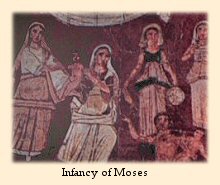 Philo of Alexandria (who lived from 20 b.c. to a.d. 50) in his treatise The Special Laws gives an interesting comment about the significance of the Jewish woman's headcovering. Regarding the procedure followed by priests who examined women accused of adultery (cf. Numbers 5:18) he writes, "And the priest shall take the barley and offer it to the woman, and shall take away from her the head-dress on her head, that she may be judged with her head bare, and deprived of the symbol of modesty, which all those women are accustomed to wear who are completely blameless." (13) The Greek word translated "modesty" here is αιδους, the genitive of αιδως ( aidos), for which we have no exact equivalent in modern English. It denotes an attitude of humility and a capacity to feel shame, in a good sense, as opposed to shamelessness or impudence. In the writings of ancient moralists this quality of αιδως (or its Latin equivalent verecundia) was often mentioned as being one of the most important feminine virtues. The same word is used by Paul in his instruction concerning women's clothing in 1 Timothy 2:9, where it is translated "shamefastness" in the KJV. But it should not be taken for granted that Jews in general attached any such definite symbolical meaning to the headcovering. Probably most Jews did not feel any need for a symbolical interpretation of the custom, and would have given it no more thought than they gave to any other article of dress.  Artistic evidence of the Jewish customs is lacking because the Jews—like the Muslims today—were adverse to the visual arts. Pictures were discouraged because of the commandment against the making of idols. (14) But there is some ancient pictorial evidence. Most notable are the frescos on the walls of an ancient Jewish synagogue in Dura Europos, Syria (dating from the middle of the third century), which portray various biblical characters, presumably in the clothing which was familiar to the Jews who used this synagogue. Here, evidently, was a congregation of deeply Hellenized Jews. Some of the men in the frescos are portrayed clean-shaven, and they do not wear tassels on their garments. (15) The very fact that this synagogue was decorated with pictures indicates that it was the home of an unusually 'liberal' congregation. But for what it is worth, we may note that the men are bare-headed (figures 23 and 24) and the women wear headcoverings ( figure 25) in these frescos. This is what we would expect to see in Syria at that time, on the basis of the literary evidence.  There is no need to suppose that this custom was observed by all peoples of the Middle East from earliest times. One wall-painting in the tomb of an Egyptian ruler, known as the The Beni Hasan painting ( figure 26), shows a group of nomadic traders from the region of Syria and Canaan arriving in Egypt with their women and children, around the year 1890 b.c. (16) This was in the days of Abraham. In this painting the women are depicted wearing headbands, without headcoverings. We also note that although the tunics of the women are longer than those of the men in the painting, they are rather close-fitting, and on three of the women they leave one shoulder bare. It may be that the clothing of the women in this painting is not entirely realistic, and follows certain artistic conventions; but it may also be taken as an indication that in those days at least some women from the region of Palestine did not ordinarily cover their heads, or observe other customs of feminine dress which seem to have become universal by the beginning of the Christian era. In any case, the usual Eastern customs of modest dress probably originated in urban settings, where standards and distinctions of dress have always tended to be more elaborate. Perhaps these customs never had much importance outside of the towns.
|
|
|
|
|
|
|
|
|
|
|
|
Truth.8 posted on 12-4-2014 02:26 PM 
Roman Headcovering Customs
Some Conclusions regarding the Customs of the TimeFrom the discussion of customs given above, it may be seen that interpreting 1 Corinthians 11:2-16 in the light of customs of the day is no simple matter. Aside from our uncertainties about Jewish, Greek and Roman customs, in Corinth we have these three cultures coming together in one place, at a time when the Greek and Roman traditions were losing their force. In fact this cultural ferment and dissolution is one of the things that set the stage for Paul's successful mission in Greece. The old gods and the old ways were dying, and the Greek world was wide open to change. 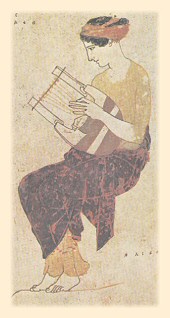 It may not even be helpful to ask about a prevailing custom in Corinth. The question presupposes that there was a prevailing custom. But Corinth was a large and diverse cosmopolitan city, and it is probably more useful to think of multiple customs and fashions rather than a single custom in this context. Corinth was not the kind of social setting in which we would expect the stability and uniformity of a traditional culture. We might compare it to a modern metropolis, such as New York City, in which one might see on the same street a significant variety of people dressed according to ethnic customs or styles of the day. Probably differences of custom and style were taken in stride, and aroused little notice. And it is entirely possible that the current fashion of some segments of the Corinthian population was to go bareheaded. Corinthian women may have been less inclined to wear a headcovering simply because it was not prescribed by custom in Corinth. One scholar has recently suggested the traditional custom of dress in Corinth was to cover the head in public, but that this Greek custom was breaking down in the first century. Bruce W. Winter has shown that in patrician Roman society, at least, many women of the first century were departing from the traditional roles and customs of wives, and this involved symbolical departures from traditional decorum in dress. Corinth, as a Roman colony, would likely have been affected by this movement as women there emulated the behavior of the high-class women in Rome. (17) In this case, Paul would be urging the Corinthian women to desist from imitating the avant-garde "fashion leaders" of Roman society and return to the traditional attire which was formerly expected of women in Corinth. Some scholars think that Paul's insistence upon the headcovering in his Greek churches is really an attempt to introduce or enforce a Jewish custom. (18) Because there was nothing especially Jewish about a woman going about with her head covered, these scholars usually maintain that Paul wants the Corinthian women to observe the face-veiling customs described by Jeremias above. But this is very doubtful, because there is nothing in the passage which suggests it, and the use of headcoverings by women in daily life was common enough throughout the ancient world that we would expect Paul to make his meaning clear if he were requiring not only this but also the face-veiling. We would expect him to use a word or expression for the face-covering or veil (καλυμμα), at least, but that is not the case here. Instead, Paul uses only a very general word for "covered," κατακαλυπτω. This word, with its prefix κατα, does however mean thoroughly covered. It cannot refer to ornamental or token headpieces, or to the headbands ordinarily used by Greek women. Even if it could be established that in Corinth and in other Greek cities of the first century women were expected to cover their heads in public, we need to ask further concerning the customs at worship. As noted above, in some religious contexts Greek women did participate in religious exercises with their heads uncovered. This may have something to do with our passage, because Paul's discussion specifically focuses on attire while praying and prophesying. Did the Corinthian women want to remove their headcoverings while praying or prophesying because this corresponded to the customs of the pagan mystery cults, in which women uncovered their heads? Perhaps they were tempted to do this. The likelihood of it is increased by the fact that there are many points of contact between the practices of the mystery cults and the issues Paul deals with in his letters to the Corinthians, and charismatic women in particular may have been vulnerable to this influence because of the focus upon emotional exaltation in the mystery cults. (19) Regarding Paul's statement about men covering their heads for prayer, some caution is in order. This statement may have nothing much to do with customs of the time. It may be, as Lenski says, that Paul talks about a man covering his head "not because some man in Corinth is liable to do such a thing, but in order to bring out the contrast with the woman." (20) In this passage his main interest is in the headcovering of women, and not of men. 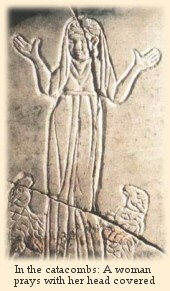 A further difficulty with all the "cultural accomodation" explanations for Paul's headcovering rule is that Paul himself offers no explanations for it along those lines. He gives other reasons. It should be noted that Paul gives no indication in any of his Epistles that he would recommend mere conformity to Greek customs as an acceptable principle of conduct for Christians. (The case is otherwise with Jewish customs, which he sometimes urges Gentiles to respect, as in 10:23–11:1). It would seem best to take his explanations at face value rather than theorize about ulterior reasons related to Greek cultural practices. In verse 16 Paul says that the woman's headcovering is a practice which pertains to the churches of God, and it may be that the use of the headcovering in the churches did not correspond exactly to either the Jewish or Greek customs of the day. (21) It probably is true that this rule in the churches was originally a Christian modification of the Jewish custom, in which the custom was somewhat liberalized. That is, Christian women were expected to wear headcoverings at religious gatherings (probably also whenever in public) without the face-veiling, even in those places (like Corinth) where the pagan society did not currently require a woman to wear any headcovering. In any case, "cultural expectations" in Corinth were probably much more complex and fluid than some scholars think they were, and I do not think that the ambiguous information and speculations about Greek customs provide us with any sure basis for a general interpretation of this passage.
Conclusion: Either Muslims women or Christian women, not necessary to cover the hair with cloth ...it all nothing but a cultural during ancient times..the Bible nor Quran never mention anything covering the head
|
|
|
|
|
|
|
|
|
|
|
|
by Kid
TAK TERJEJAS LANGSUNG... takde kaitan apapun, macamana nak terjejas darjat pulak.
Kalau tak terjejas langsung, apasal ada fatwa bodoh? 
Orang Islam suka sangat buat fatwa utk benda2 bodoh tetapi bila berhadepan dgn isu keganasan, berdiam diri je. Sebab itulah orang Islam itu semuanya PENGANAS rata2.  |
|
|
|
|
|
|
|
|
|
|
|
By Sephiroth
Kalau tak terjejas langsung, apasal ada fatwa bodoh?
Kalau pasal tu kau kena tanya langsung orang tu.
Mungkin dia orang bodoh...
|
|
|
|
|
|
|
|
|
|
| |
|